Some of the links in this post may be affiliate links.
In my experience, this is one of the most gratifying houseplants, that also doubles as a WONDERFUL plant for your summer garden. There are many characteristics why Tradescantia pallida, also known as Purple Heart Plant or Wandering Jew, makes a spectacular plant:
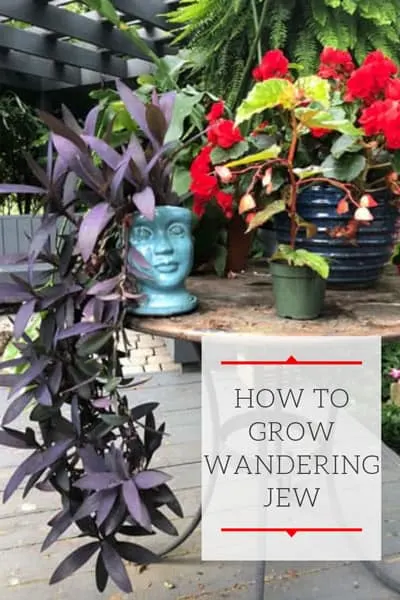
- It grows very quickly.
- The purple color of the leaves is almost unmatched!
- It is extraordinarily easy to propagate and will save you a lot of money if you propagate your indoor plant and use for your outdoor pots.
- It is a very versatile plant that can be grown indoors and outdoors.
Table of Contents
Purple Heart Lost Its Purple Color?
Did your Tradescantia pallida purpurea, or purple heart plant, lose its purple color and you want it back? After all, it is supposed to be purple right? It’s in the name!
The answer for this is simple…LIGHT!
Whether you purchased this plant in the houseplant section of a nursery, or in the summer annual section of the nursery, chances are it was purple. Very purple!
Then you brought the plant indoors and it slowly lost its purple color and turned to a boring shade of green.
This would especially be the case during the winter time. Not fair right?! It’s not called Green Heart…it’s called Purple Heart.
Don’t despair though. Keep reading and I will teach you everything I know about this plant from my personal experience.
Light Requirements
Tradescantia pallida plants like full sun. In fact, they demand it in order for them to retain their stunning purple color.
If your plants have turned much less purple, or even changed to a green color, you can easily get your purple color back by placing it into direct sun.
So if you are growing these plants indoors, move it to the sunniest window that you can.
If your plant has been growing in a pretty dark area and you suddenly move it to a super-sunny window, you may want to make the move a little more gradual so that your plant does not burn.
Anytime you are increasing light levels drastically, always do it gradually. Especially if your plant has been indoors all winter and you want to place it outdoors.
Place it in full shade first for a few days, and then give it an hour or two of direct sun for while, and increase from there.
Be sure to go back and read my blog post about how I transition plants to go outdoors safely.
Indications Your Plant is Not Getting Enough Light
There are a few indications that your Tradescantia pallida is not receiving enough light:
- The leaves used to be purple but then turned green
- The growth seems weaker
- The leaves and stems may be thinner
Watering
There is nothing unusual about water requirements for this plant. I just give these plants my “standard” approach to watering.
When grown indoors, I wait until the top inch or so of the soil becomes dry, and then I will give it a thorough watering. Simple. This is a good approach for most plants.
Don’t ever let these completely dry out though, otherwise the plants will quickly suffer. Conversely, don’t let them sit in water for any period of time. Check on your plants regularly!
If you have these plants outdoors, the frequency at which you water will be very different. Depending on the temperatures and light levels, you may need to water them either daily or every other day. It all depends!
If the surface of the soil feels dry, it is time to water. If it is still damp or a little moist, then hold off another day and check again later.
Tradescantia Pallida: Indoors vs. Outdoors
Unless you have a super sunny window indoors, these plants will not reach their full glory. But you can EASILY winter them over indoors and then take cuttings to propagate new plants for your summer outdoor garden!
Like I mentioned earlier, if you’ve had a pot of Tradescantia pallida growing outdoors, and you bring it indoors to continue growing throughout the winter, you will notice that the leaves will most likely lose their beautiful purple color. They will turn mostly, or completely, green.
In addition to the color changing, you will also notice weaker, lankier growth when plants are grown indoors.
However, if you have the room, you can easily propagate these plants for beautiful summer pots outdoors! Keep reading to see how I do it.
Purple Heart Propagation
First off, let me start off by saying that you shouldn’t be scared of hacking your plant up when you propagate! So many people are scared to cut anything off of a plant.
This is one of the easiest plants that you can propagate. It’s literally as simple as making some cuttings and throwing them in water.
Take a look at these cuttings that I made from a plant that I used to have outdoors, but then moved it indoors to grow over the winter.
You can see that the leaves turned completely green indoors due to darker conditions indoors during the winter.
I took cuttings in late winter, rooted them, and then made a separate pot with the cuttings.
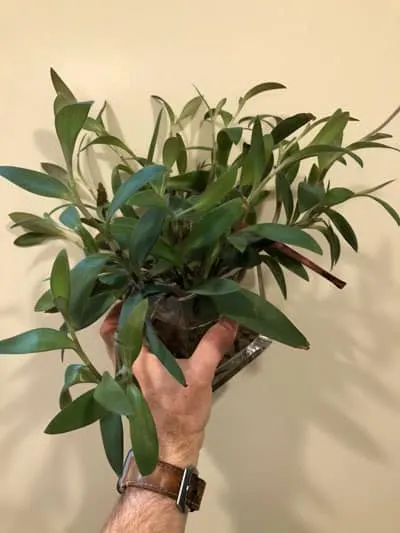
Simply take some stem cuttings, strip the lower part of the stem of any leaves, and place them in a vase or jar with water. They should quickly root.
Be sure to change your water about once a week at least to keep it fresh. Try not to have any leaves submerged underwater because they will spoil the water and encourage rotting.
There are two benefits to doing this. The original plant will grow back stronger, and you will have created a brand new plant (or two…or three) with your cuttings!
When taking cuttings from your original plant, don’t cut all the stems off. Be sure to leave some leaves. Although it will look unsightly for a bit, it will grow back stronger and bushier, especially when you move the plants outdoors.
When you have some roots on your cuttings, you can either take all the cuttings and plant them in one pot if you’d like a bushy specimen, or you can create as many pots as you’d like. Have some fun!
Since I plant an obscene number of pots outdoors in the summer, I normally make my own soil blend in order to save money.
When I don’t have my own blend on hand, especially before I’m able to get outside before the weather is nice, I typically use Miracle-Gro potting mix.
I achieve great results with using Miracle-Gro potting mixes. In addition to being a great potting mix, they are also environmentally conscious.
I also found out from speaking with a nursery owner that to make the Miracle Gro potting mixes, they actually take food scraps from grocery stores, compost them down, and use it to make their potting mix.
It’s a great potting mix for your plants, in addition to being a very environmentally beneficial choice! The more we can minimize material going into landfills, the better!
Take a look at how beautiful the propagated cuttings looked after just a few short months outdoors.
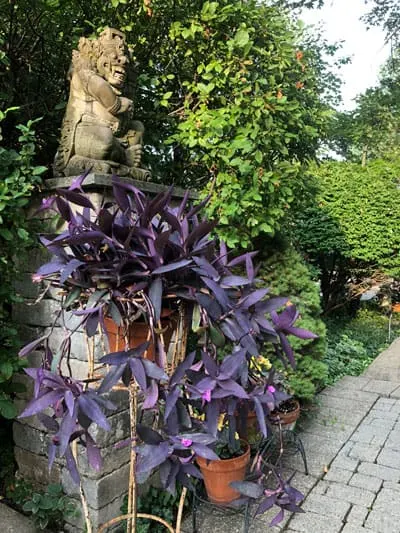
Transitioning Tradescantia Outdoors
To really achieve the true beauty of this plant, you should move it outdoors during the warm summer months. The plant really won’t achieve it’s prime beauty indoors unless you have a location with a lot of direct sun!
Wait until the evenings are minimum 50F, and then you can place your Tradescantia pallida outdoors.
Start out FIRST by placing the plant in FULL shade.
Although these plants like sun, if they have been indoors all winter, the growth will be weak and the plants will burn very quickly if you suddenly place them in a lot of direct sun outdoors right away.
Leave the plant in full shade for a few days. Even a week. You can’t really go too slow, but if you rush the process, you will burn your plant.
Then move your plant to a location that gets an hour or two or direct sun. Preferably morning sun. Leave it in that location for another week or so.
You should start to notice your leaves turning more and more purple by this point. Then you can gradually increase the sun exposure more if you’d like.
The moral of the story is to do it slowly. This process that I’ve described is referred to as hardening off a plant. You must ALWAYS harden off a plant when moving it from indoors to outdoors. Even for plants that are sun-loving.
Plants grow much weaker indoors due to many factors including much lower light levels, poor air circulation, and other factors. So you must take some care to harden off your plants.
After your plant looks like it is taking off and is fully adjusted to being outdoors, be sure that you start a regular fertilization schedule. For foliage plants, I love using Miracle-Gro fertilizer.
To achieve maximum growth and beauty, you really need to fertilize your outdoor plants. It will make the difference between a mediocre plant and an exceptional specimen.
Have you grown Tradescantia pallida before? Share your experiences in the comments!

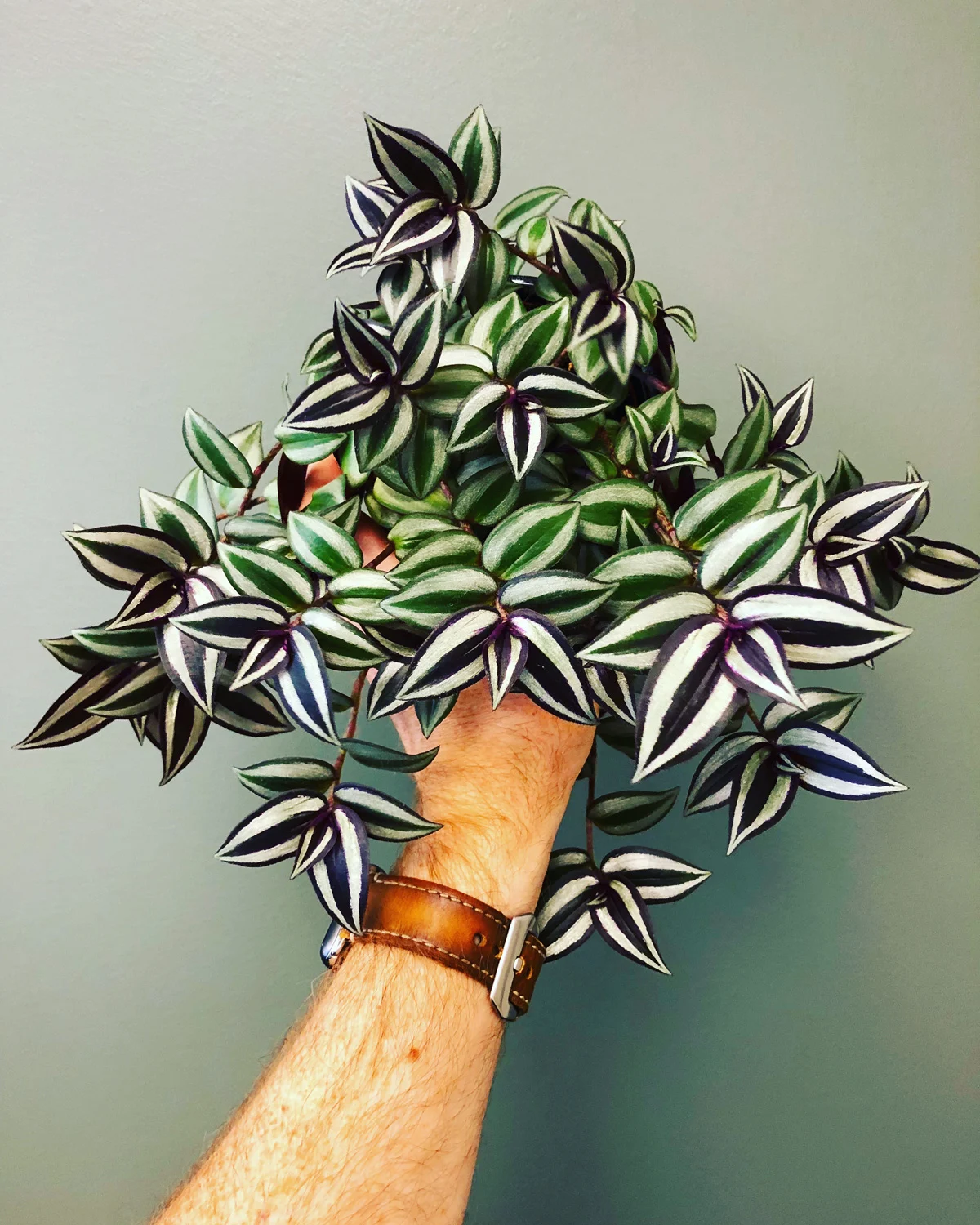
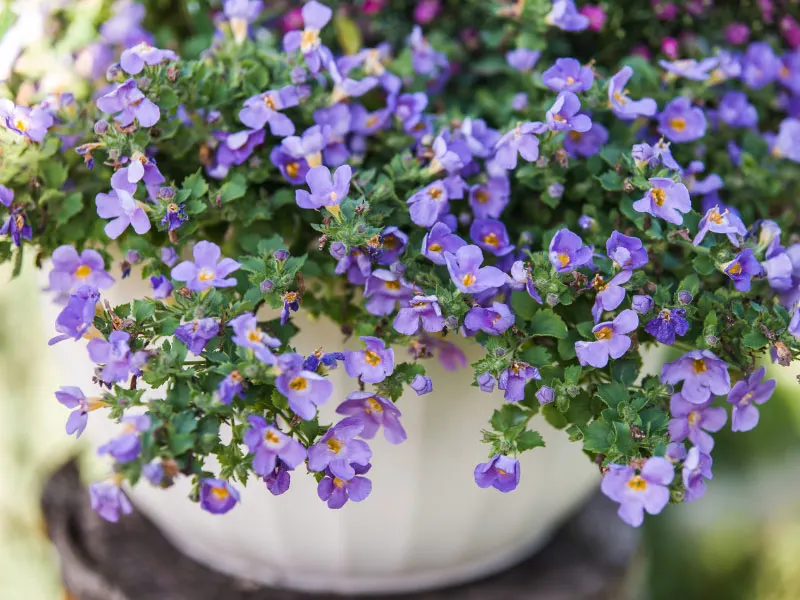
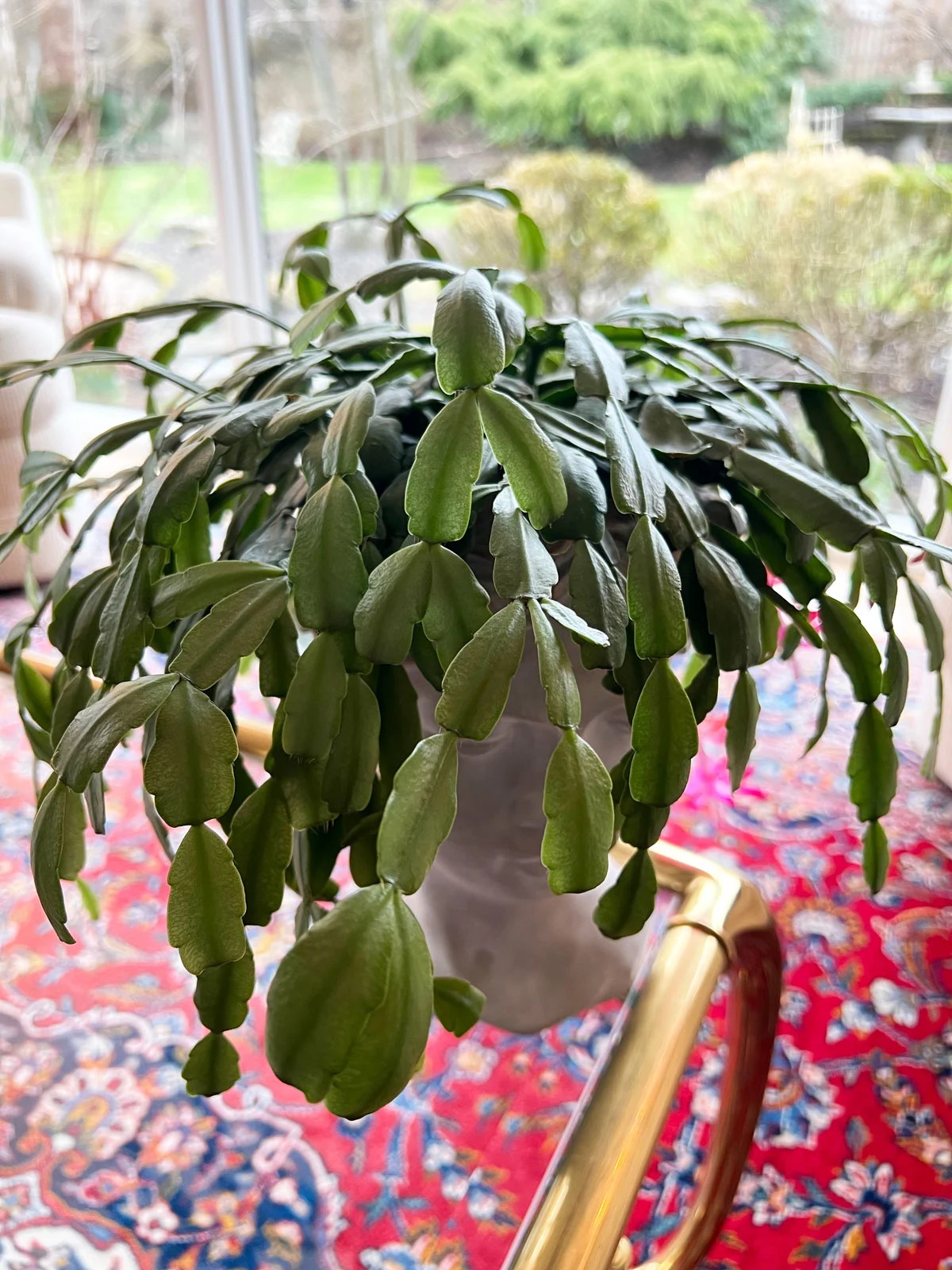
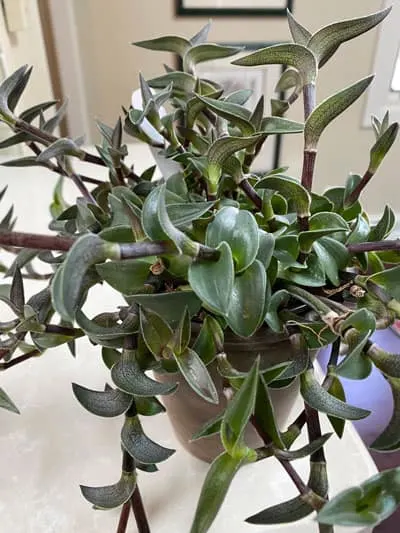
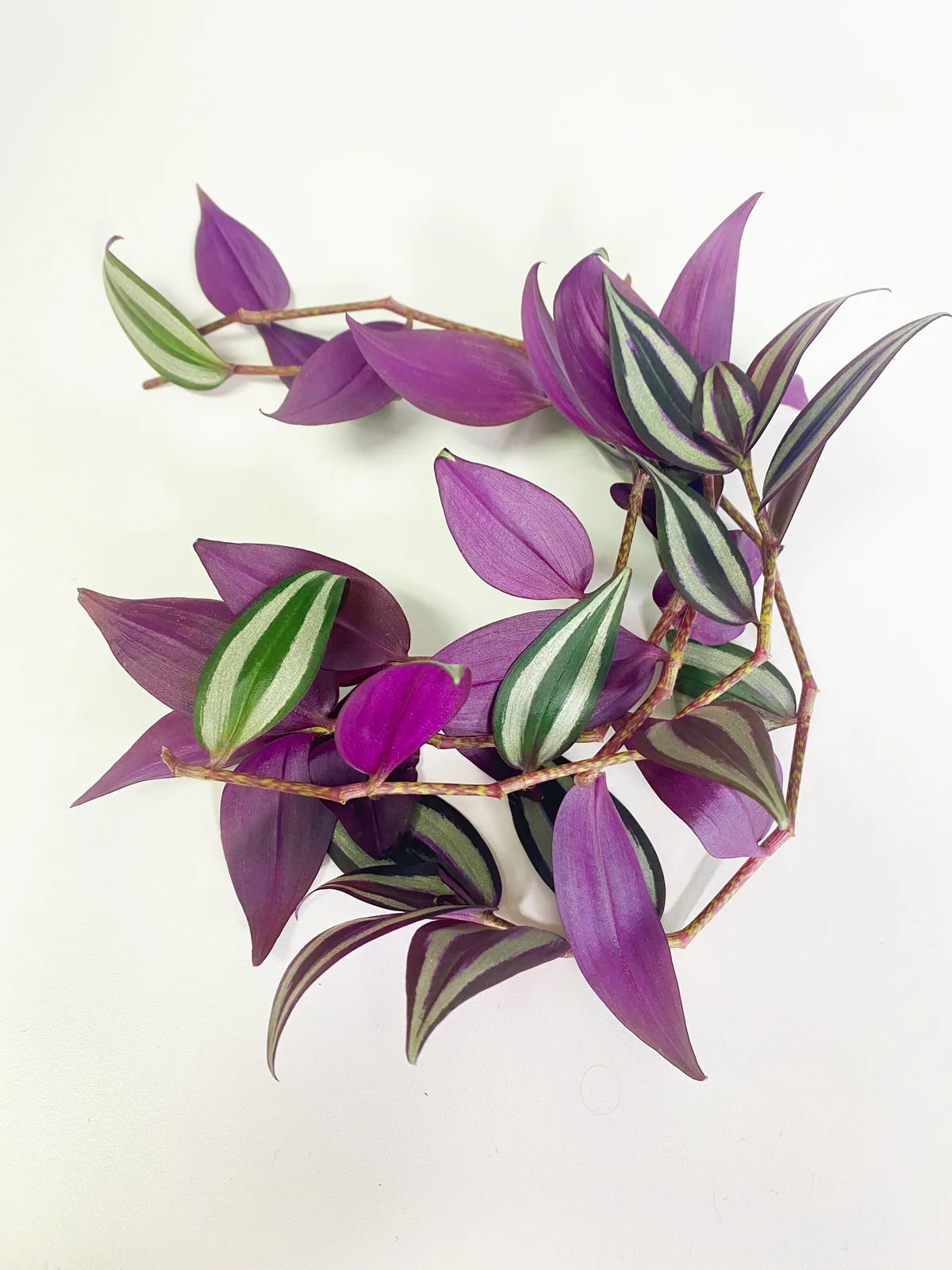
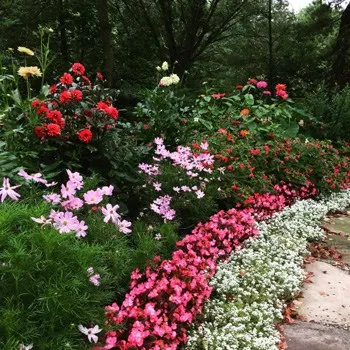
Audrey
Tuesday 23rd of April 2024
I use Purple Heart as my hanging baskets on my porch. Once I moved them into the Weekender pot, large self-watering, they’ve been much happier. I over winter indoors. When I take them outside I give them a cut and propagate to plant in the landscape. When I bring them in I give a cut and propagate overwinter in buckets. They are ready for the landscape in spring. They’re color is a welcome addition everywhere.
Raffaele Di Lallo
Friday 26th of April 2024
Hi Audrey! Sounds like a lovely specimen plant, and they sure do add beautiful color to the landscape!
Amber
Sunday 24th of July 2022
Hello, I have had my wandering Jew on my porch that gets direct sunlight all morning, into the afternoon…I had recently repotted them into terra cotta pots, then one of them started turning green and very willty and stringy looking, but the other one was still very purple and now it’s turning green…I only water it when the top soil is dry and it drains well…don’t know what else to do
Raffaele
Sunday 24th of July 2022
Hi Amber, just be careful with the terra cotta pots as they will dry out much more quickly. It could be that you didn't water your plant sufficiently when you repotted. Be sure to give your plant a really good soaking. Sometimes, when using new potting mix, it can be really dry and you have to work at it to moisten it sufficiently. Just a couple things to think about. Make sure you do keep giving them enough sun (at least half a day).
Raina
Sunday 21st of November 2021
Please note that purple heart/lady/queen is a COMPLETELY other plant than wandering Jew!
Looks wise oyster plant is only one I can see confused as wandering Jew!
Raffaele
Monday 22nd of November 2021
I included this because it is sometimes called that by some (but it's exactly the reason why I dislike common names because they can often mean different things to different people :-). I always encourage people to use botanical names.
Jay
Sunday 1st of August 2021
When I move the plant outdoors, will the existing green leaves turn purple again? Or only the new growth will be purple?
Raffaele
Tuesday 3rd of August 2021
Hi Jay! Yes, the existing leaves will turn purple as well :-) Just be careful to acclimate your plant slowly when moving it from indoors to outdoors. Put it in the shade first for a few days and then gradually move to sun (but do it slowly) otherwise your plant will burn. Good luck!
Sondra Kay Cannon
Sunday 15th of November 2020
This plant is very invasive. Be careful or it will take over your planting bed.
Raffaele
Monday 16th of November 2020
I haven't had any issues in my climate. I've planted them for years, but only in my pots and not in the ground.